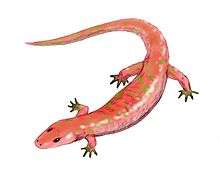Albanerpetontidae
The Albanerpetontidae are an extinct family of superficially salamander-like batrachians. Albanerpetontids include five genera – Albanerpeton, Anoualerpeton, Celtedens, Shirerpeton and Wesserpeton – and between 10 and 20 known species, spanning about 160 million years from the Bathonian stage of the Middle Jurassic to the beginning of the Pleistocene, about 2.13-2 million years ago.[1][2] Albanerpetontids were long thought to be salamanders because of their small size and generalized body plans.[3] However, these features are now thought to be ancestral for lissamphibians and not indicative of close relationships between the two groups. One of the things that made them different from salamanders was that their skin was embedded with bony, fish like scales.[4] Albanerpetontids are now recognized as a distinct clade of lissamphibians separate from the three living orders of amphibians – Anura (frogs), Caudata (salamanders), and Gymnophiona (caecilians). Some studies show them as more closely related to frogs and salamanders than to caecilians,[5] while others show them to be outside of the lissamphibian crown-group.[6] The presence of epipterygoids and a separate supraoccipital at least argues against a position within Batrachia.[7]
| Albanerpetontidae | |
|---|---|
 | |
| Life restoration of Albanerpeton | |
| Scientific classification | |
| Kingdom: | Animalia |
| Phylum: | Chordata |
| Class: | Amphibia |
| Superorder: | Batrachia |
| Order: | †Allocaudata Fox and Naylor, 1982 |
| Family: | †Albanerpetontidae Fox and Naylor, 1982 |
| Genera | |
Taxonomy
Compiled from Paleofile.com and Mikko Haramo's websites.[8][9]
- Genus Shirerpeton Matsumoto & Evans, 2018[10]
- Species Shirerpeton isajii Matsumoto & Evans, 2018
- Genus Wesserpeton Sweetman & Gardner 2013
- Species Wesserpeton evansae Sweetman & Gardner 2013
- Genus Anoualerpeton Gardner, Evans & Sigogneau-Russell 2003
- Species A. priscus Gardner, Evans & Sigogneau-Russell 2003
- Species A. unicus Gardner, Evans & Sigogneau-Russell 2003
- Genus Celtedens McGowan & Evans 1995
- Species C. megacephalus (Costa 1864)
- Species C. ibericus McGowan & Evans 1995
- Genus Albanerpeton Estes & Hoffstetter 1976
- Species A. arthridion Fox & Naylor 1982
- Clade "Gracile-snouted"
- Species A. gracilis Gardner 2000
- Species A. cifellii Gardner 1999
- Species A. galaktion Fox & Naylor 1982
- Clade "Robust-snouted"
- Species A. nexuosus Estes 1981
- Species A. pannonicus Venczel & Gardner 2005
- Species A. inexpectatum Estes & Hoffstetter 1976
Additionally, a specimen of an undescribed albanerpetonid is known from the Cenomanian aged Burmese amber in Myanmar. The specimen had been published in a paper mistakenly as a chamelonid lizard.[10]
References
- Gardner, J.D.; Böhme, M. (2008). Sankey, J.T.; Baszio, S. (eds.). Vertebrate Microfossil Assemblages: Their Role in Paleoecology and Paleobiogeography (PDF). Indianapolis: Indiana University Press. pp. 178–218. Retrieved 9 January 2012.
- Villa, Andrea; Blain, Hugues-Alexandre; Delfino, Massimo (2018). "The Early Pleistocene herpetofauna of Rivoli Veronese (Northern Italy) as evidence for humid and forested glacial phases in the Gelasian of Southern Alps". Palaeogeography, Palaeoclimatology, Palaeoecology. 490: 393–403. doi:10.1016/j.palaeo.2017.11.016. ISSN 0031-0182.
- Duellman, W.E. & Trueb, L. (1994): Biology of amphibians. The Johns Hopkins University Press
- Wesserpeton evansae: making 'albanerpetontid' a household name
- Gardner, J. D. (2001). "Monophyly and affinities of albanerpetontid amphibians (Temnospondyli; Lissamphibia)". Zoological Journal of the Linnean Society. 131 (3): 309–352. doi:10.1111/j.1096-3642.2001.tb02240.x.
- David Marjanović and Michel Laurin, Reevaluation of the largest published morphological data matrix for phylogenetic analysis of Paleozoic limbed vertebrates, Article · December 2015 DOI: 10.7287/peerj.preprints.1596v1
- Ryoko Matsumoto; Susan E. Evans (2018). "The first record of albanerpetontid amphibians (Amphibia: Albanerpetontidae) from East Asia". PLoS ONE. 13 (1): e0189767. doi:10.1371/journal.pone.0189767. PMC 5752013. PMID 29298317.
- Mikko's Phylogeny Archive Haaramo, Mikko (2007). "†Allocaudata – albanerpentonids". Retrieved 30 December 2015.
- Paleofile.com (net, info) "Archived copy". Archived from the original on 2016-01-11. Retrieved 2015-12-30.CS1 maint: archived copy as title (link). "Taxonomic lists- Amphibia". Archived from the original on 5 March 2016. Retrieved 30 December 2015.
- Ryoko Matsumoto; Susan E. Evans (2018). "The first record of albanerpetontid amphibians (Amphibia: Albanerpetontidae) from East Asia". PLoS ONE. 13 (1): e0189767. doi:10.1371/journal.pone.0189767. PMC 5752013. PMID 29298317.